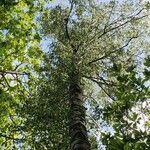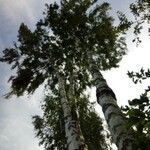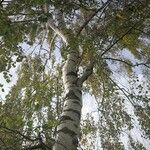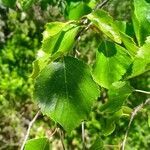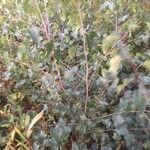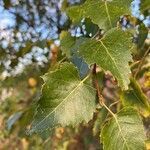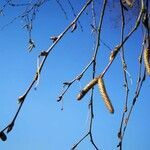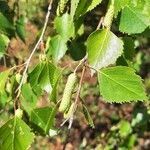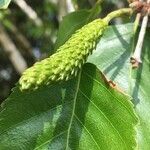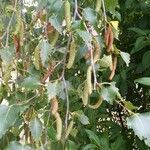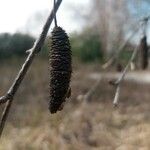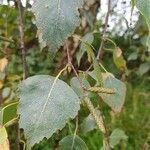Trees , to 25 m; trunks usually several, crowns spreading. Bark of mature trunks and branches creamy to silvery white, smooth, exfoliating as long strands; lenticels dark, horizontally expanded. Branches pendulous; twigs glabrous, usually dotted with small resinous glands. Leaf blade broadly ovate to rhombic with 5--18 pairs of lateral veins, 3--7 × 2.5--5 cm, base cuneate, rarely truncate, margins coarsely and sharply doubly serrate, apex acuminate; surfaces abaxially glabrous to sparsely pubescent, covered with minute, resinous glands. Infructescences erect to nearly pendulous, cylindric, 2--3.5 × 0.6--1 cm, shattering with fruits in fall; scales adaxially sparsely pubescent, lobes diverging at middle, central lobe obtuse, much shorter than lateral lobes, lateral lobes broad, rounded, extended. Samaras with wings much broader than body, broadest near center, extended beyond body apically. 2 n = 28, 56.
Tree to c. 25 m high; branchlets slender, often semi-drooping. Bark smooth at first, silvery-white and papery, usually becoming dark grey and rough at least on lower trunk. Shoots glabrous, ± glandular-resinous, prominently lenticellate and appearing warty. Petiole slender, mostly 7-25 mm long. Lamina 3-6 × 1.5-5.5 cm, deltoid, ovate or rhombic-ovate, glabrous, with 5-7 pairs of veins, glandular-resinous when young, coarsely and doubly serrate; base subcordate, truncate or broadly cuneate; apex acuminate. ♂ catkins 2-9 cm long; bract 2-3 mm long, shield-like, both bract and bracteoles ciliolate. ♀ catkins 1.5-2.5 cm long, scarcely elongating at fruiting but becoming broadly cyclindric and c. 0.7 cm wide. Stigmas rose. Scales 3.5-4.5 × 4-5 mm, puberulent; lateral lobes broader and rounder than middle lobe, widespreading and often ± downward curving. Fr. 1.5-2.5 mm long; wing much > fr.
A deciduous tree. It grows 15-25 m tall. It spreads to 6-9 m wide. The bark is white. The branches hang downwards. It loses its leaves during the year. The leaves are diamond shape. Some have deeply lobed leaves. The leaves are 3-7 cm long. There is a tapering tip. The male or pollen catkins are in groups of 2-4. The mature seed catkins are 2-4 cm long. They hang down. They are at the end of twigs. The female catkins are upright.
Occasionally escapes from cult. and would key to B. populifolia. It has drooping twigs; middle-sized trunks are beset with vertical, diamond-shaped, rough black marks that eventually coalesce.
